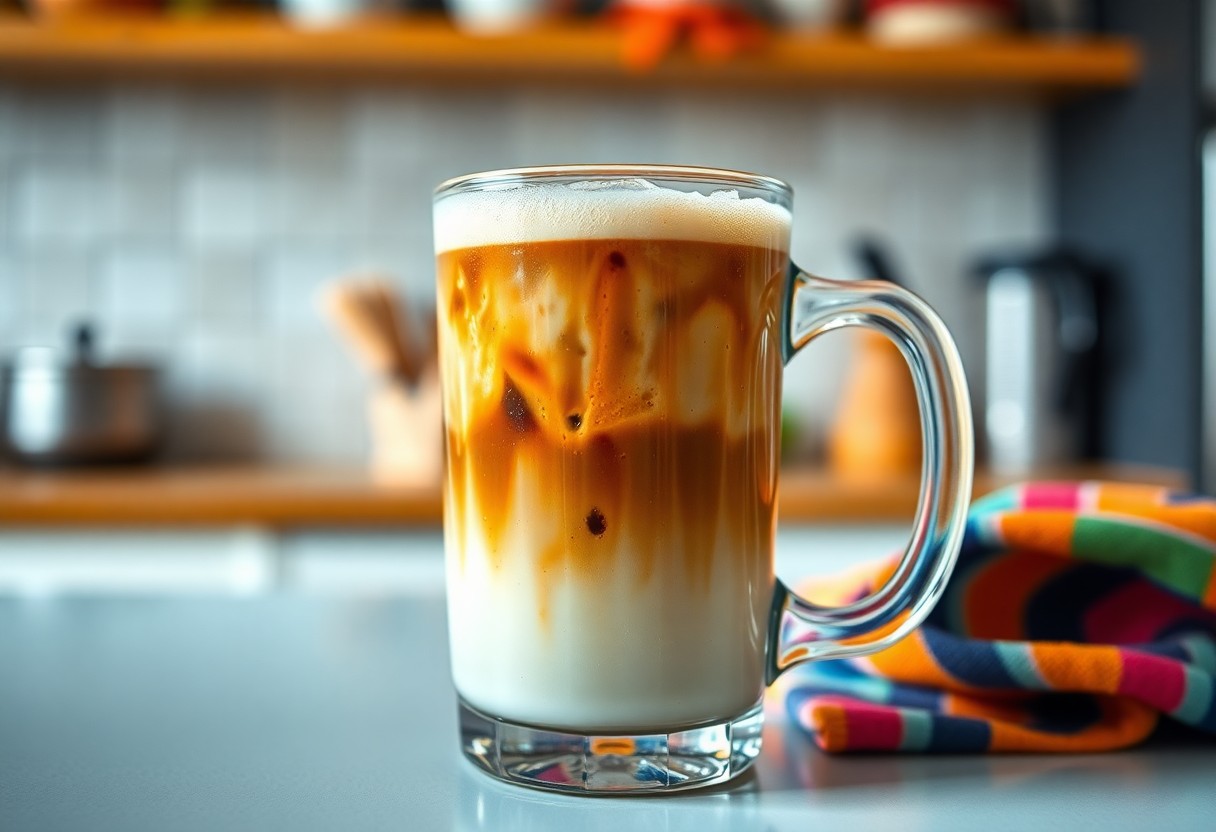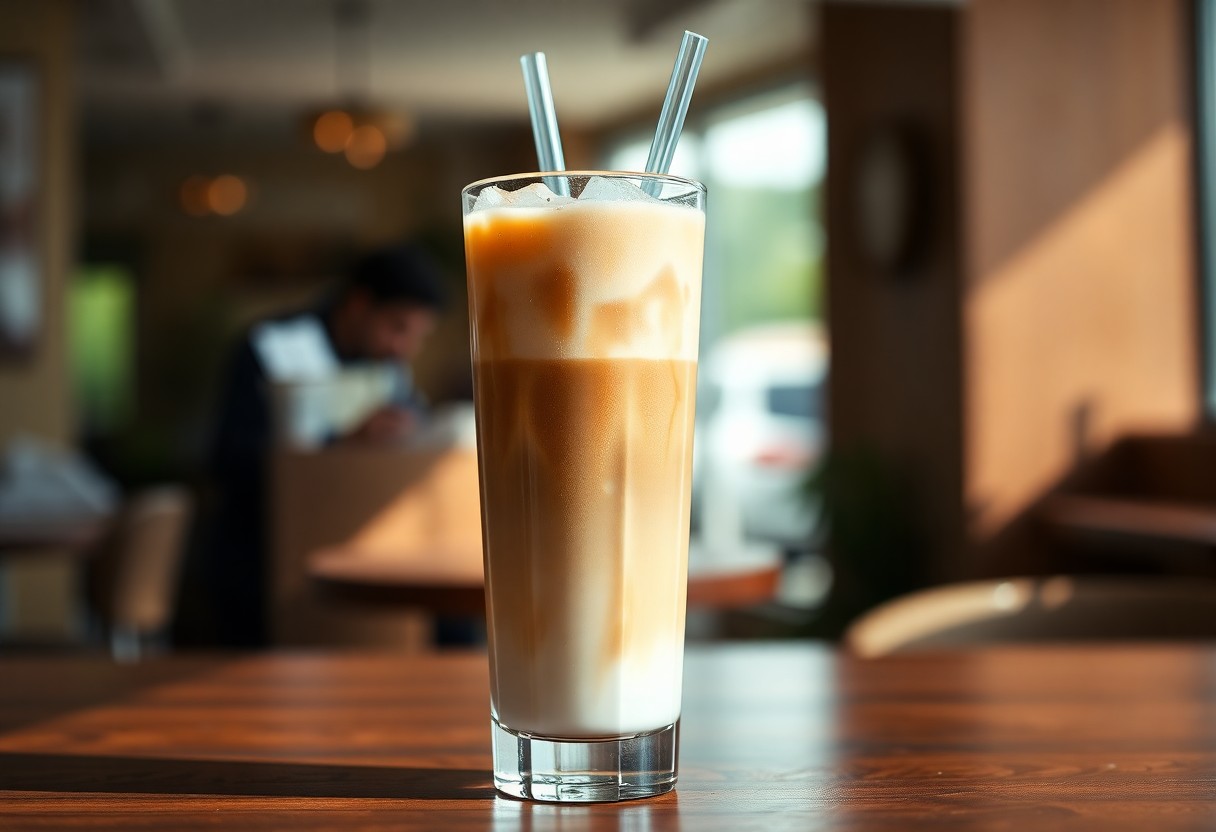There’s a delightful art to crafting layered iced lattes that not only look stunning but also maintain their separation of flavors. You can transform your daily coffee routine into a visually appealing experience by following a few simple techniques. From the choice of ingredients to the method of pouring, every step matters in achieving that beautiful, layered effect. With the right approach, you can enjoy a drink that’s as picturesque as it is delicious, ensuring your iced latte remains a feast for both the eyes and the taste buds.

Key Takeaways:
- Begin by using chilled ingredients, as cold components prevent layers from mixing.
- Pour the coffee slowly over the back of a spoon to minimize the impact and maintain distinct layers.
- Use contrasting densities in your ingredients; for example, alternate between lighter milk options and heavier syrups to enhance separation.

The Science of Layer Separation
Achieving perfect layer separation in your iced lattes hinges on understanding the science behind it. The distinct layers not only enhance the visual appeal of your drink but also provide a unique tasting experience. By manipulating temperature, density, and ingredient composition, you can create stunning beverages that remain beautifully segregated until you’re ready to mix them. This section dives into the principles that govern these layers and how you can effortlessly replicate them at home.
Density and Temperature: How They Influence Layering
| Factor | Description |
| Density | Ingredients with higher sugar or cream content are denser and will sit below lighter liquids like coffee or milk. |
| Temperature | Using chilled or room temperature ingredients can help maintain segregation, as temperature affects the viscosity and flow of liquids. |
The Role of Sugar and Cream in Creating Distinct Layers
Sugar and cream play an necessary role in achieving the beloved layers in your iced latte. Cream, due to its fat content, is less dense than liquid coffee, allowing it to float above it when poured correctly. The addition of sugar increases the density of the components, impacting how layers form. By adjusting the sugar and cream ratios, you can create a visually appealing striped effect while enhancing the flavor profile of your drink. Experimentation with these variables allows you to personalize your lattes and perfect the art of separation, ensuring every sip is as delightful as the last.
Ingredients That Will Make a Difference
Choosing the right ingredients is vital for achieving that beautiful separation in your layered iced lattes. Start with high-quality coffee, rich syrups, and diverse layering agents to elevate your creation. Select ingredients not just for flavor, but also for their density and temperature, as these factors will influence how well they maintain their distinct layers. A successful iced latte isn’t solely about taste; it’s a visual feast that requires thoughtful ingredient selection to look as impressive as it tastes.
Choosing the Right Coffee Base for Contrast
Your coffee base plays a major role in creating a striking contrast against the other layers. Opt for a bold, robust espresso or cold brew, which tend to have a heavier body compared to lighter roasts. This density will help your coffee remain at the bottom of the glass, while lighter ingredients, such as syrups or milk, effortlessly float on top. Experiment with different roasts and brewing methods to find the perfect flavor that complements your chosen layering agents.
Dairy vs. Non-Dairy: Finding Your Perfect Layering Agents
Milk selection can dramatically influence the final appearance and taste of your layered iced latte. Dairy milk, including whole or skim, offers creaminess that can help create a luscious layer, while options like almond or oat milk bring different flavor profiles. Both types serve their purpose, but their densities will vary; for instance, full-fat coconut milk can produce a striking layer due to its richness. Aim for options that not only taste great but also enhance the visual appeal.
Look into specific non-dairy options that have become popular for layering iced lattes. Oat milk is increasingly favored for its thickness and slightly sweet flavor, which makes it a great candidate for the middle layer. On the other hand, almond milk can often be thinner, so if you’re using it, consider mixing it with a thicker alternative or using less to maintain that beautiful separation. By understanding the differences in density, you can choose the right agent to achieve stunning layers that are both delicious and visually appealing.
Mastering the Pour Technique
Perfecting the pour technique transforms your iced latte from a simple drink to an impressive work of art. Achieving that desired layered effect hinges on your pouring angle, speed, and the combination of your liquids. Start with the densest liquid at the bottom, gradually adding lighter ingredients while pouring over the back of a spoon or the side of your glass to minimize turbulence and promote separation. With practice, you’ll develop a rhythm that allows you to create visually breathtaking layers while keeping each ingredient distinct and flavorful.
Tips for Layering Liquids with Precision
Achieving perfect layers involves attention to detail, and these tips will elevate your latte game:
- Pour liquids with different densities carefully to avoid merging.
- Utilize a spoon to guide the flow of each layer.
- Experiment with temperatures—cool liquids work best for layering.
- Practice your timing by pouring slowly and steadily.
This combination of techniques will ensure your iced latte not only looks stunning but also maintains that coveted layered aesthetic.
Using Tools: The Right Glassware and Pouring Devices
Choosing the right tools enhances your layering experience dramatically. Opt for clear, tall glasses to showcase your creation, preferably with a wide mouth that allows for easy pouring. Pouring devices such as spouted measuring cups or squeeze bottles offer precision, enabling you to control the flow of your liquids. Consider using a cocktail jigger for smaller pours, perfect for adding the finishing touches like flavored syrups or creamers, ultimately creating visually appealing layers.
Flavor Innovations: Beyond Vanilla
Exploring flavors beyond the classic vanilla opens up a world of creativity for your layered iced lattes. Consider unique additions such as caramel, hazelnut, or innovative fusions like lavender and chocolate. Each flavor can bring a new dimension, enhancing the visual appeal and taste experience for your drink. When you experiment with various flavors, you can craft iced lattes that not only look captivating but also excite the palate with unexpected flavor profiles.
Crafting Custom Syrup Combinations for Unique Layers
Creating custom syrup combinations elevates your iced lattes. Combine raspberry with white chocolate for a sweet, tangy contrast or pair cinnamon with maple for a cozy, autumn-inspired drink. Adjusting the ratios also allows you to fine-tune the intensity of each layer, achieving a perfect balance that stands out visually and tastes delicious.
Experimenting with Spice and Flavor Enhancers
Adding spices and flavor enhancers can transform your iced latte into a unique beverage. Consider incorporating cardamom, nutmeg, or even a hint of sea salt to create complex layers of flavor. Chili powder can lend a surprising kick, while ginger brings a refreshing zing. These enhancements not only introduce new notes but also complement the core flavors, inviting enticing aromatic experiences as you sip.
When experimenting with spice, you’ll find that even a pinch of cinnamon or a dash of matcha powder can create captivating flavors that resonate through each layer of your latte. Consider a chai spice blend for a comforting feel, pairing it with a creamy milk base for warmth. Alternatively, try adding vanilla extract paired with cardamom to amplify the luxurious notes in your drink. The key is to start small and gradually build on flavors, ensuring each element maintains its integrity while creating harmonious flavor combinations.
Troubleshooting Common Separation Failures
Even the most meticulous layering efforts might not achieve the stunning results you envision. If your iced latte isn’t staying beautifully separated, a few common issues usually lurk beneath the surface, such as incorrect pouring technique or mismatched densities. Identifying these failures quickly will allow you to recalibrate your methods without delay, ensuring each creation is a visual delight as well as a flavorful treat.
Identifying and Solving Layering Issues
Layering issues often stem from rapid mixing during the pouring process or using ingredients that are too similar in density. Pouring too quickly can create turbulence, while ingredients like cold foam and whipped cream may not sit as intended. To remedy the situation, try adjusting your angle when pouring or using a spoon to guide your liquid as it falls into the glass.
Adjusting Ratios and Techniques for Optimal Results
A key factor in achieving distinct layers is the ratio of ingredients and the techniques employed. For a stunning iced latte, consider a 3:1 ratio of milk to coffee; this balance allows the heavier coffee to sit below the milk while remaining distinct. Experimenting with temperature can also yield significant differences—using ice-cold milk and slightly warmer brewed coffee works wonders for separation.
For optimal layering, fine-tuning ratios and temperatures is important. You can play around with different milk types, as dairy cream is denser than plant-based alternatives. For instance, using whole milk can create a striking contrast with espresso. Furthermore, the specific order of pouring can greatly impact the effect. Start with the heaviest ingredients first and use a spoon to gently layer the lighter ones, ensuring each component maintains its distinct character. Keep experimenting until you find the combination that gives you that eye-catching result you’re aiming for.
Conclusion
To wrap up, mastering the art of creating layered iced lattes is all about technique and the right ingredients. By carefully choosing your milk, espresso, and flavoring options, you can achieve stunning visual layers that not only look appealing but also enhance the taste experience. Pour your ingredients slowly over the back of a spoon and consider the density of each component to maintain those distinct layers. With practice, you’ll be able to impress yourself and others with your beautifully separated iced lattes.
FAQ
Q: What are the key components for a layered iced latte?
A: To create a beautiful layered iced latte, you will need freshly brewed espresso, cold milk (dairy or non-dairy), ice cubes, and a sweetener of your choice. Using different densities of liquids, such as cold milk and hot espresso, helps achieve the layers.
Q: How do I brew the perfect espresso for layering?
A: Brew your espresso using high-quality coffee beans and ensure the water temperature is between 195°F and 205°F. Use a fine grind and a proper extraction time of about 25-30 seconds. Allow the espresso to cool slightly before layering it over the milk to maintain its distinct layer.
Q: Why do my layers mix together when I pour the liquids?
A: Mixing occurs when the liquids are poured too quickly or are too similar in temperature, density, or viscosity. To maintain the layers, pour the espresso over the back of a spoon or directly onto the ice cubes. This gentler technique helps to slow down the pour and keeps the layers intact.
Q: Can I use flavored syrups or sweeteners in my layered iced lattes?
A: Absolutely! Flavored syrups or sweeteners can be added to either the milk or the espresso, depending on your preference. To keep the layers distinct, add these sweeteners to the milk first, then pour in the espresso to create the layered effect.
Q: How can I prevent the ice from diluting my iced latte too quickly?
A: To minimize dilution, you can use larger ice cubes or coffee ice cubes (made from frozen brewed coffee) in your layered iced latte. This way, your drink will stay cold without the ice melting quickly and mixing into the layers. Another option is to chill your milk and espresso before layering them.
